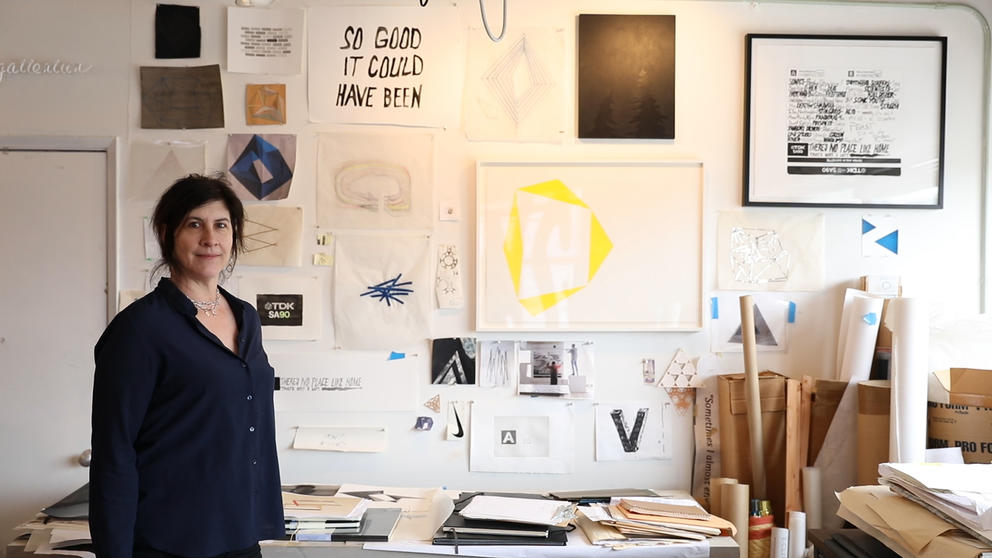Clearly visible to anyone commuting to and from downtown via Highway 99 (as well as brave souls taking Mercer Avenue eastbound), “Banner Year” consists of regularly changing signs facing out from two windows in Haven’s fourth-floor studio in South Lake Union.
The first installment read “STILL LIFE,” one word filling each floor-to-ceiling window, written in what appeared to be thick black handwriting on white paper. When it popped up in January, it gave the impression of a message in a bottle washed ashore. If you happened to spot it above Aurora Avenue, it seemed as if someone from a mysterious location was trying to communicate something important, calling out from a thicket of construction cranes.
“Still lifes were the first artworks ever made,” Haven says, “and I was referring to stillness in a location where everything else is moving so fast. I was also saying, ‘We are still here, there is still art in this building.’”
Erected in 1920 for the J.T. Hardeman Hat Company, the four-story structure is a holdout from a bygone era, now dwarfed by sleek new apartments at the west edge of South Lake Union. Though the tan paint is peeling and the façade is riddled with cracks, it emanates a certain creaky gravitas among the eager new architectural baubles in the neighborhood. It has held creators for most of its existence — fur and felt hat makers, students and teachers at the School of Visual Concepts, the Seattle Makers collective and a long line of artists renting individual studios.
Haven has rented her space since 2011. “I’m perfectly oriented to watch the city change all around me,” she says. Her windows look out across Aurora at the Space Needle, MoPop and the Bill & Melinda Gates Foundation. “I was hoping for a year,” she recalls thinking when she first moved in. “Maybe a year and a half.” Having worked in nine previous local studios over the course of her career — all of which were demolished for new development — she knows better than to get too comfortable.
True to one of her sculptural pieces that reads, “Iampayingattention,” Haven has used her hometown’s rapid growth as an instigator of new work. In “Proposed Land Use Action,” a 2012 show at SAM, she displayed a large painting she had made on the wall of a previous (doomed) studio. The catch: she had to saw the chunk right out of the drywall. In her current studio, she set up time-lapse cameras to track the changing city — Bertha tunnel construction, demolition of the Hostess Factory, high rises sprouting up downtown. She ended up with 500,000 shots, which she condensed into a video called “Studio X” and displayed at the Frye Art Museum in 2015.
“This has given me a way to talk about time on a large sale,” Haven says. “I might be kicked out of this building tomorrow. But there’s also the sense of everything that’s happened in this place.”
In her formal work, Haven is known for abstract, geometric forms (such as the angular “Blue Sun” displayed at the Olympic Sculpture Park pavilion last year). But she is also drawn to narrative, history and language. “I think a lot about this building as part of a story,” she says.
“PLOT DEVICE,” said the second installment. “I don’t want these word pairs to be too literal,” she notes.
Haven plans to change out the Banner Year installations every week or so throughout 2018. Though she has a few in mind, she wants to play it by ear. “MONEY BALLS” referred to her proximity to the Amazon spheres and the Bill & Melinda Gates Foundation (“I’m sitting in this ancient, crumbling structure surrounded by billionaires,” she says, laughing). “TUNNEL VISIONS” appeared recently, after WSDOT announced that the Highway 99 tunnel would be completed earlier than expected. Asked if she considers the signs a form of activism, Haven says they're “subversive abstractions.”

“I want to keep it oblique and poetic,” she says. Sometimes there may be no language at all, only shapes. She’s excited about the project, especially as a looser approach to art than she’s used to. “It’s the opposite of my formal work. I usually compress, reduce, beat things to death,” she says. “I’m having so much fun being fast.” The process is not entirely freewheeling — Haven has painstakingly created a Photoshop alphabet out of the handwriting on a long-ago mixtape. She chooses each letter, measures it out, and uses a projector to outline the words on a wall before painting them.
“CULT CLASSIC,” says the newest installment. She likes imagining what people think in the short span when she’s only got the first word up in one window.
Haven’s studio is peppered with evidence that seems to suggest a yearning for an older (perhaps classic) version of the city — a bumper sticker reading “Fremont Sucks Now,” a sweatshirt that says, “I Got Hammered at Hardwick's” (the beloved and soon-to-shutter hardware store), even a book of short stories titled “Homesick for Another World.” One can’t help but wonder if Seattle’s increasingly unrecognizable landscape might finally prompt her to pack up and head out.
“I often talk about my relationship with the city as somebody who has tried to leave, and successfully left for one or two year periods, but I always end up coming back,” she says. “Even with Seattle becoming a larger city, it has a hold on me. My roots are here. It’s in my bones. It’s really provided me with the kind of headspace I need.”
Crosscut arts coverage is made possible with support from Shari D. Behnke.


